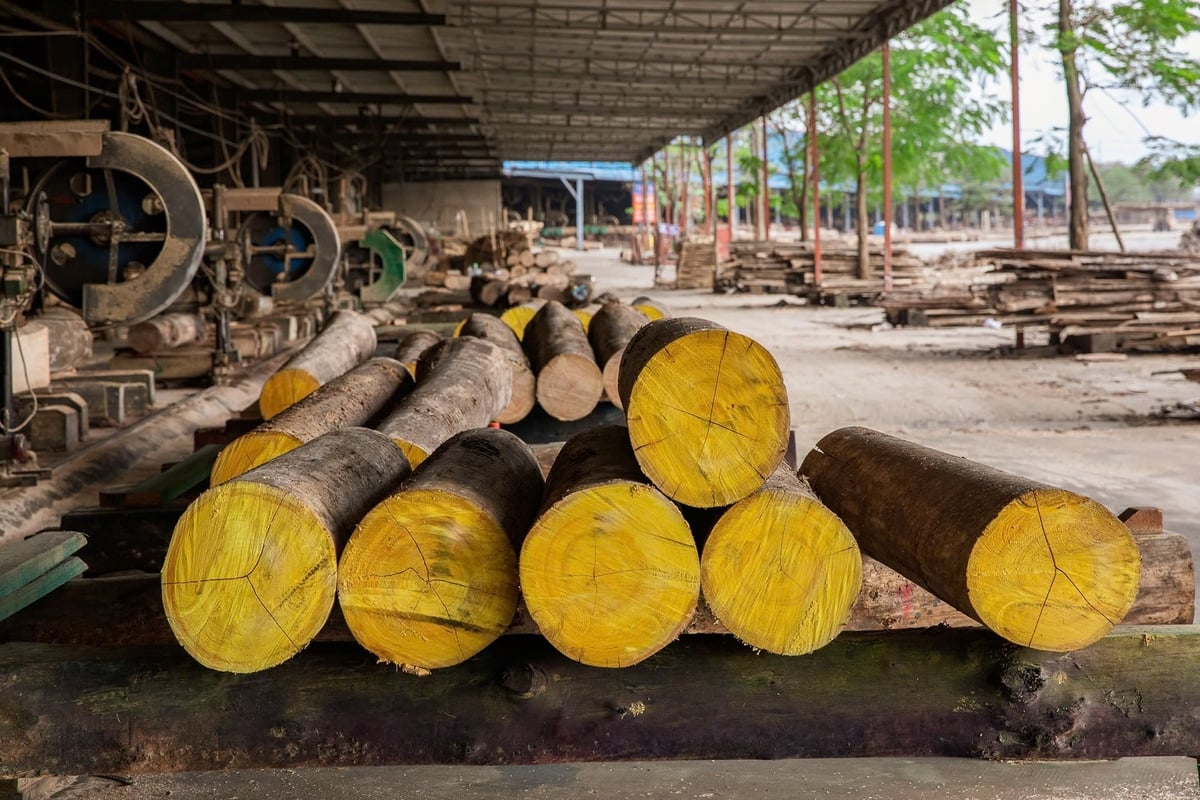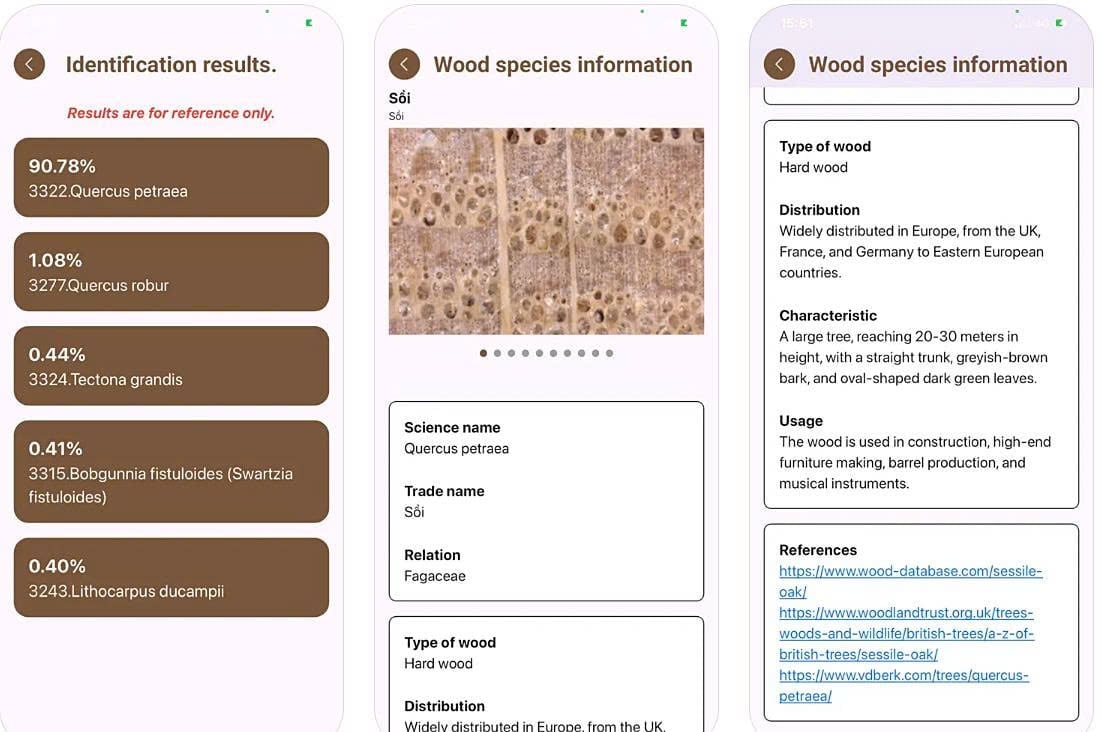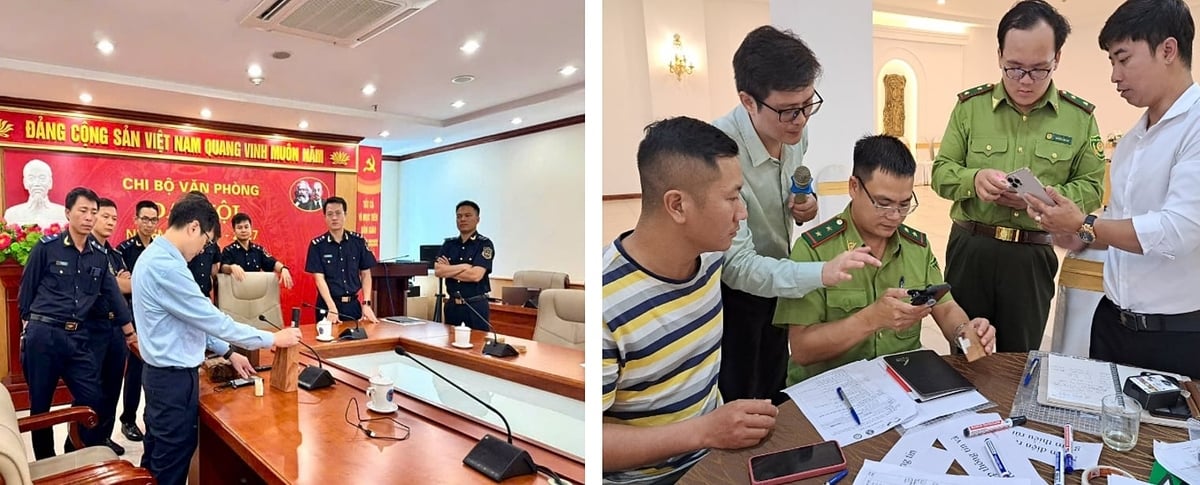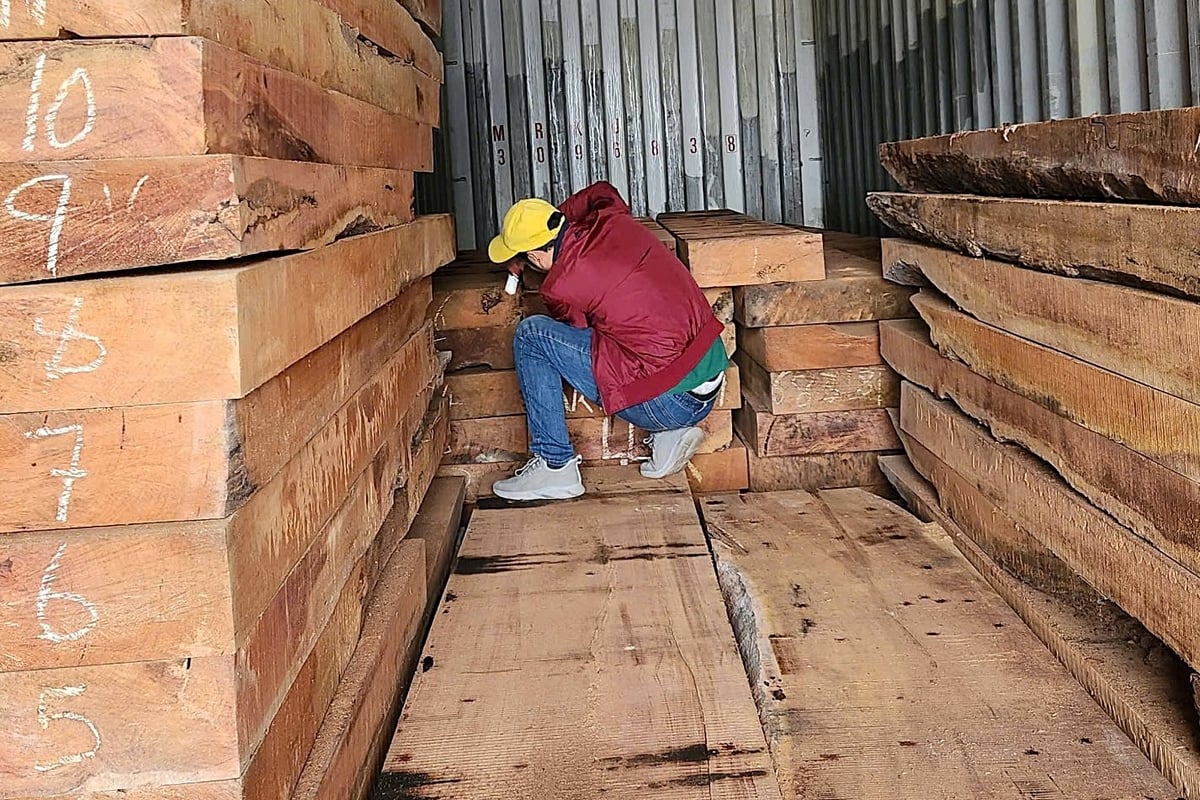December 31, 2025 | 10:28 GMT +7
December 31, 2025 | 10:28 GMT +7
Hotline: 0913.378.918
December 31, 2025 | 10:28 GMT +7
Hotline: 0913.378.918
As part of the project “Support to implementation of the VPA/FLEGT Agreement in Vietnam”, the Vietnam Administration of Forestry and Forest Protection (under the Ministry of Agriculture and Environment) collaborated with the Deutsche Gesellschaft für Internationale Zusammenarbeit (GIZ), with support from experts of the Research Institute of Forest Industry (RIFI) under the Vietnamese Academy of Forest Sciences (VAFS) and AITC Consulting and AI Development Company, to build the Vn‑WoodID toolkit to enable accurate and convenient wood species identification.

Imported roundwood stored at the port and yard in Binh Duong. Photo: GIZ/Binh Dang.
Vn‑WoodID is an ecosystem comprising a mobile app for Android and iOS and a wood sample library maintained at the Forest Research Institute.
The Vn‑WoodID app enables fast, accurate automatic identification using AI to achieve instant species recognition on mobile devices. It supports Vietnam’s efforts to ensure the legality, sustainability, and transparency of wood supply chains globally.
The Vn‑WoodID database is built on nearly 3,000 wood samples from 260 species collected in high‑risk origin regions such as Africa, Asia, and South America. It includes commonly imported species, newly emerging species, and endangered species that are often illegally harvested.
The 260 species include 181 species imported into Vietnam; 7 rare species listed in Appendices IA and IIA under Decree 84/2021/ND‑CP (amending Decree 06/2019/ND‑CP on management of endangered forest plants and animals and CITES implementation); 12 species exchanged with Indonesia’s National Research and Innovation Agency (BRIN); and 60 species sampled (image data) at the Timber Industry Development Department (TIDD) in Takoradi, Ghana.

Wood species identification result after using Vn-WoodID. Photo: Bao Thang.
After collection, each sample is identified by two methods: (1) macroscopic and microscopic comparison per IAWA guidelines, international databases, and reference specimens; (2) mass spectrometry (DART‑TOFMS) analysis compared with data from US‑WISC. Only samples matching both methods are included in the database to ensure the highest accuracy and reliability.
Vn‑WoodID also includes a macroscopic anatomical database with detailed images for each species. Users can directly compare actual wood samples with digitized data. Each species has at least 300 transverse cross‑section images clearly showing growth rings, sapwood/heartwood, early/late wood, rays, parenchyma, and vessels. Images must align wood rays parallel to the image edges, be free of cracks, cut marks, or reflective glare, and include both rays and annual rings.
The database also provides full species information: scientific name, trade name, natural distribution, wood density class, morphological traits, and identifying characteristics. It also integrates conservation status, CITES listing, and current legal regulations related to management and trade. This becomes a rapid reference tool to support legality checks and risk assessments of imported wood shipments.

Customs and forest protection trainees identifying wood species using the AI-powered wood identification app. Photo: RIFI.
Vn‑WoodID uses a state‑of‑the‑art deep learning model trained on nearly 100,000 images of wood cross‑sections at 50x magnification. The model achieved up to 98.6% accuracy on test data. It is optimized to run directly on mobile phones without Internet, producing results in under one second. The app is streamlined for non‑specialist users, making it easy for customs officers and forest rangers without deep anatomical training to identify species quickly.
Vn‑WoodID supports direct connection to two imaging devices: electron microscopes and external magnification lenses. The interface is user‑friendly and intuitive. The image capture, storage, and file‑naming process is standardized by species identifier codes, simplifying centralized management and data retrieval like never before.
Thanks to these features, Vn‑WoodID acts as an initial “filter” to detect anomalies, reducing time and cost of in‑depth forensic analysis.
According to Nguyen Huu Thien, Deputy Director of the Vietnam Administration of Forestry and Forest Protection, Vn‑WoodID is especially useful for customs agencies checking high‑risk wood shipments and for forest rangers verifying imported and market‑traded timber. Wood importers and processors can use Vn‑WoodID to fulfil due diligence, avoid legal risks from misidentification or false species declarations. The software is also beneficial for teaching, research in wood anatomy and biodiversity conservation.

Experts from the Forest Industry Research Institute collecting and verifying wood samples at Hai Phong Port. Photo: RIFI.
Dr. Nguyen Bao Ngoc, Deputy Director of the Research Institute of Forest Industry, notes that Vn‑WoodID is not just rapid species identification software but also a digital solution for supply chain transparency, improving governance efficiency, and protecting forest resources.
Developing this wood identification tool exemplifies Resolution 57/NQ/TW's viewpoint, which identifies science, technology, innovation, and digital transformation as breakthrough drivers for modernizing production capacity and boosting productivity, efficiency, and sustainability.
The image and species database remains foundational. Expanding the database is essential to enhance application effectiveness in the future. This expansion should be open and involve multiple stakeholders, especially business communities, wood industry associations, universities, and research institutes.
During a recent mission to Ghana, GIZ Vietnam collaborated with the Ghana Forestry Commission to expand the database by adding 60 wood species, while also learning from Ghana’s effective implementation of the VPA/FLEGT.
At the same time, GIZ hopes that Vn‑WoodID will become a powerful tool in the fight against timber smuggling and in strengthening the capacity to verify legality throughout Vietnam’s timber supply chain.
Translated by Huong Giang

(VAN) From extensive shrimp ponds, baskets of don gathered on the mudflats, to boats carrying visitors to watch birds, all livelihoods here depend on clean water, green forests, and the calls of migratory birds.
/2025/12/26/0703-3-204813_117.jpg)
(VAN) Transparency in information and listening to local people have helped address ground clearance bottlenecks and build social consensus, thereby accelerating the progress of the JICA3 irrigation project.
/2025/12/27/0609-3-233846_327.jpg)
(VAN) The JICA3 project is expected to become a 'water shield,' helping control saltwater intrusion, proactively secure water resources, protect livelihoods, and promote sustainable development in coastal areas.
/2025/12/26/5654-3-164509_655.jpg)
(VAN) As Viet Nam makes strong commitments toward achieving net-zero emissions, controlling and reducing methane emissions in livestock production is increasingly becoming a mandatory requirement.

(VAN) 'People, Primates, Plants: Co-managing Biodiversity and Improving Livelihoods in Vietnam' (the PPP Project) is an international initiative implemented in Vietnam by BGCI, CEGORN, and ICRAF/World Agroforestry.

(VAN) Dak Nong established a risk-level zoning map for coffee, built a digital data platform for the sector, and promoted certified production in line with EUDR.
/2025/12/25/2709-1-211551_295.jpg)
(VAN) In response to the U.S. Marine Mammal Protection Act (MMPA), Gia Lai province is implementing many solutions to protect marine mammals and develop sustainable, responsible fisheries.